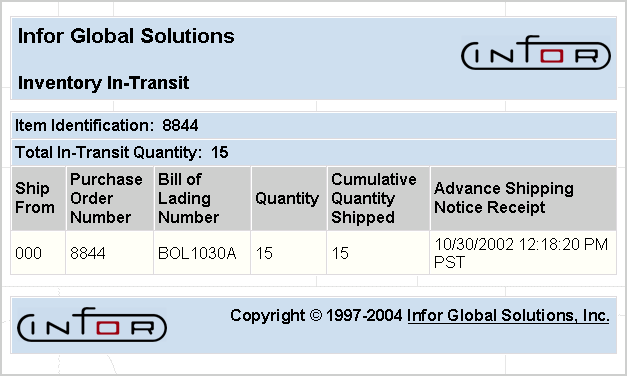What are Goods in Transit in Accounting Transit Inventory

This also means goods in transit belong to, and arethe responsibility of, the buyer. The point of transfer is when thegoods leave the seller’s place of business. By implementing these strategies, businesses can effectively manage transit inventory, optimize supply chain operations, reduce costs, enhance customer satisfaction, and gain a competitive edge in the market.
FOB Shipping Point
This way, you can ensure accurate numbers and make better-informed decisions based on real historic data from all areas of your business. At Business.org, our research is meant to offer general product and service recommendations. We don’t guarantee that our suggestions will work best for each individual or business, so consider your unique needs when choosing products and services. For the past 52 years, Harold Averkamp massachusetts state tax information (CPA, MBA) hasworked as an accounting supervisor, manager, consultant, university instructor, and innovator in teaching accounting online. For the past 52 years, Harold Averkamp (CPA, MBA) has worked as an accounting supervisor, manager, consultant, university instructor, and innovator in teaching accounting online. From a legal standpoint, the title passes from one party to the other when the goods reach the FOB point.
Shipping Term Effects
The treatment of goods in transit can significantly influence a company’s financial statements, affecting both the balance sheet and the income statement. When goods are shipped under FOB Shipping Point terms, the seller recognizes revenue at the point of shipment, which can lead to an earlier reflection of sales in the income statement. This early recognition can enhance the company’s revenue figures for the period, potentially improving financial ratios and investor perceptions. Conversely, the buyer must record the inventory in transit, which increases their current assets and impacts their working capital calculations.
5 Discuss and Record Transactions Applying the Two Commonly Used Freight-In Methods

This also means goods in transit belong to, and are the responsibility of, the buyer. The point of transfer is when the goods leave the seller’s place of business. The consignor does not recognize revenue until the consignee sells the goods, which can lead to fluctuations in revenue recognition depending on the consignee’s sales performance. This arrangement can create variability in the consignor’s financial results, making it essential for them to closely monitor consignment sales and returns.
- In-transit inventory can be a great asset to your company, as long as it’s properly accounted for.
- The goods in transit still belong to the group (parent and subsidiary), so the balance must exist in the consolidated balance sheet.
- Delivery Expense increases (debit) and Cashdecreases (credit) for the delivery charge of $120.
- So, in this case, the journal entry will be recorded by BDF Inc. in its books of account on February 5, 2020.
When analysing your in-transit inventory, you might discover that some items are in fact losing you money based on how long they take and how much they cost to deliver. Although it comes at an extra cost (you still have to pay the premium even if you never make a claim), shipping insurance is considered a wise choice – especially for businesses shipping high-value goods. And that means it needs to be accurately recorded and managed just like the products that are still sitting in your storage facility.
Discussion and Application of FOB Destination
For accounting purposes, the seller recognizes revenue at the point of shipment, and the buyer records the inventory once the goods are in transit. This method is particularly advantageous for sellers as it allows them to recognize revenue earlier. However, it also places the risk of loss or damage during transit on the buyer, necessitating careful consideration of insurance and logistics arrangements. For transactions under FOB Destination terms, the seller retains ownership and responsibility for the goods until they reach the buyer.
This method requires robust internal controls to ensure accurate tracking and reporting of consigned goods. ShipBob also has inventory analytics that help make everything from year-end accounting reports to recording inventory much easier. Let us take an example in which SDF Inc. is the seller, and BDF Inc. is the purchaser. SDF Inc. ships merchandise worth $50,000 on January 15, 2020, and it is yet to reach BDF Inc. Determine which company should record the goods in transit in their accounting books if the terms of the delivery freight are on board (FOB)shipping point. If FOB shipping point is listed on the purchasecontract, this means the buyer pays the shipping charges(freight-in).
Freight-in refers to the shipping costs forwhich the buyer is responsible when receiving shipment from aseller, such as delivery and insurance expenses. When the buyer isresponsible for shipping costs, they recognize this as part of thepurchase cost. The cost principle requires thisexpense to stay with the merchandise as it is part of getting theitem ready for sale from the buyer’s perspective. The shippingexpenses are held in inventory until sold, which means these costsare reported on the balance sheet in Merchandise Inventory. Whenthe merchandise is sold, the shipping charges are transferred withall other inventory costs to Cost of Goods Sold on the incomestatement.
Finally, add this cost to your average inventory shipment to arrive at the total cost of your in-transit inventory. In a perpetual inventory system where the inventory account is updated continuously, debit inventory and credit cash; if it is a credit purchase, debit accounts payable. Goods in Transit refers to the goods that is left the shipping dock of the seller, but not yet reached the receiving dock of the buyer.
